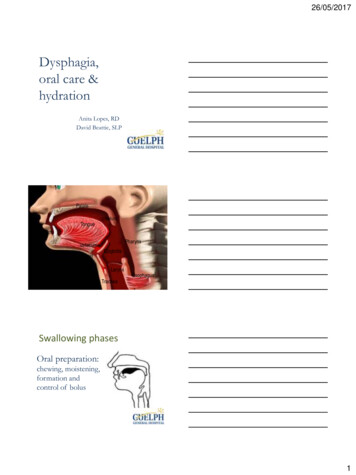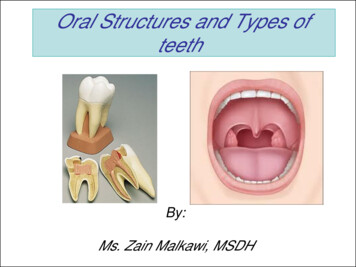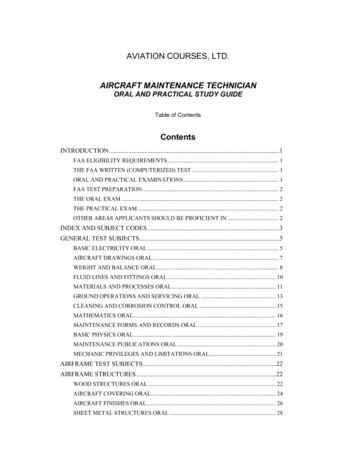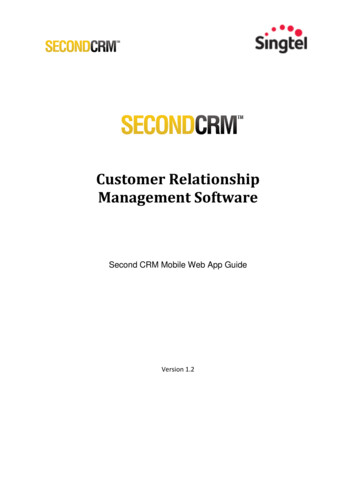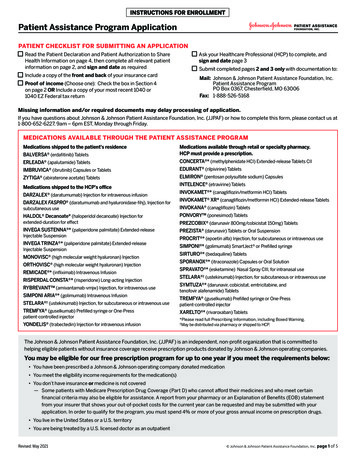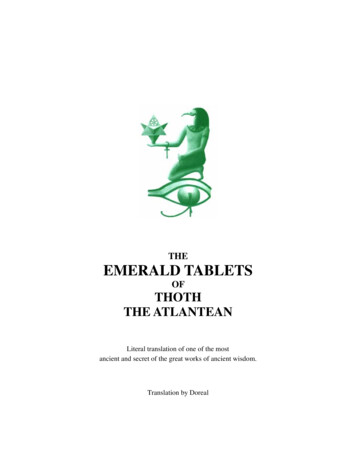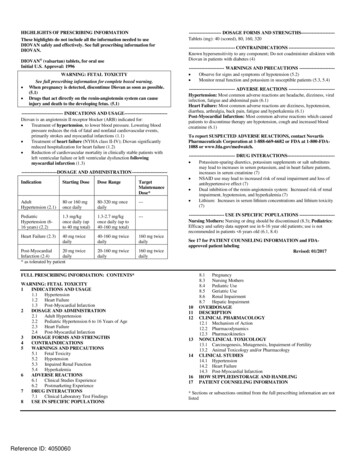
Transcription
HIGHLIGHTS OF PRESCRIBING INFORMATIONThese highlights do not include all the information needed to useDIOVAN safely and effectively. See full prescribing information forDIOVAN.DIOVAN (valsartan) tablets, for oral useInitial U.S. Approval: 1996WARNING: FETAL TOXICITY See full prescribing information for complete boxed warning.When pregnancy is detected, discontinue Diovan as soon as possible.(5.1)Drugs that act directly on the renin-angiotensin system can causeinjury and death to the developing fetus. (5.1)--------------------------- INDICATIONS AND USAGE---------------------------Diovan is an angiotensin II receptor blocker (ARB) indicated for: Treatment of hypertension, to lower blood pressure. Lowering bloodpressure reduces the risk of fatal and nonfatal cardiovascular events,primarily strokes and myocardial infarctions (1.1) Treatment of heart failure (NYHA class II-IV); Diovan significantlyreduced hospitalization for heart failure (1.2) Reduction of cardiovascular mortality in clinically stable patients withleft ventricular failure or left ventricular dysfunction followingmyocardial infarction (1.3)-----------------------DOSAGE AND ADMINISTRATION ---------------------- IndicationStarting DoseDose RangeTargetMaintenanceDose*AdultHypertension (2.1)80 or 160 mgonce daily80-320 mg oncedaily-- PediatricHypertension (6 16 years) (2.2)1.3 mg/kgonce daily (upto 40 mg total)1.3-2.7 mg/kgonce daily (up to40-160 mg total)-- Heart Failure (2.3)40 mg twicedaily40-160 mg twicedaily160 mg twicedailyPost-Myocardial20 mg twiceInfarction (2.4)daily* as tolerated by patient20-160 mg twicedaily160 mg twicedaily--------------------- DOSAGE FORMS AND STRENGTHS--------------------- Tablets (mg): 40 (scored), 80, 160, 320------------------------------ CONTRAINDICATIONS ----------------------------- Known hypersensitivity to any component; Do not coadminister aliskiren withDiovan in patients with diabetes (4)----------------------- WARNINGS AND PRECAUTIONS ---------------------- Observe for signs and symptoms of hypotension (5.2) Monitor renal function and potassium in susceptible patients (5.3, 5.4)------------------------------ ADVERSE REACTIONS ----------------------------- Hypertension: Most common adverse reactions are headache, dizziness, viralinfection, fatigue and abdominal pain (6.1)Heart Failure: Most common adverse reactions are dizziness, hypotension,diarrhea, arthralgia, back pain, fatigue and hyperkalemia (6.1)Post-Myocardial Infarction: Most common adverse reactions which causedpatients to discontinue therapy are hypotension, cough and increased bloodcreatinine (6.1)To report SUSPECTED ADVERSE REACTIONS, contact NovartisPharmaceuticals Corporation at 1-888-669-6682 or FDA at 1-800-FDA 1088 or - DRUG INTERACTIONS------------------------------ Potassium-sparing diuretics, potassium supplements or salt substitutesmay lead to increases in serum potassium, and in heart failure patients,increases in serum creatinine (7) NSAID use may lead to increased risk of renal impairment and loss ofantihypertensive effect (7) Dual inhibition of the renin-angiotensin system: Increased risk of renalimpairment, hypotension, and hyperkalemia (7) Lithium: Increases in serum lithium concentrations and lithium toxicity(7)----------------------- USE IN SPECIFIC POPULATIONS ---------------------- Nursing Mothers: Nursing or drug should be discontinued (8.3); Pediatrics:Efficacy and safety data support use in 6-16 year old patients; use is notrecommended in patients 6 years old (6.1, 8.4)See 17 for PATIENT COUNSELING INFORMATION and FDAapproved patient labelingRevised: 01/2017FULL PRESCRIBING INFORMATION: CONTENTS*WARNING: FETAL TOXICITY1INDICATIONS AND USAGE1.1Hypertension1.2Heart Failure1.3Post-Myocardial Infarction2DOSAGE AND ADMINISTRATION2.1Adult Hypertension2.2Pediatric Hypertension 6 to 16 Years of Age2.3Heart Failure2.4Post-Myocardial Infarction3DOSAGE FORMS AND STRENGTHS4CONTRAINDICATIONS5WARNINGS AND PRECAUTIONS5.1Fetal Toxicity5.2Hypotension5.3Impaired Renal Function5.4 Hyperkalemia6ADVERSE REACTIONS6.1Clinical Studies Experience6.2Postmarketing Experience7DRUG INTERACTIONS7.1Clinical Laboratory Test Findings8USE IN SPECIFIC POPULATIONSReference ID: 4050060101112131416178.1Pregnancy8.3Nursing Mothers8.4Pediatric Use8.5Geriatric Use8.6Renal Impairment8.7Hepatic ImpairmentOVERDOSAGEDESCRIPTIONCLINICAL PHARMACOLOGY12.1 Mechanism of Action12.2 Pharmacodynamics12.3 PharmacokineticsNONCLINICAL TOXICOLOGY13.1 Carcinogenesis, Mutagenesis, Impairment of Fertility13.2 Animal Toxicology and/or PharmacologyCLINICAL STUDIES14.1 Hypertension14.2 Heart Failure14.3 Post-Myocardial InfarctionHOW SUPPLIED/STORAGE AND HANDLINGPATIENT COUNSELING INFORMATION* Sections or subsections omitted from the full prescribing information are notlisted
FULL PRESCRIBING INFORMATIONWARNING: FETAL TOXICITY When pregnancy is detected, discontinue Diovan as soon as possible. (5.1)Drugs that act directly on the renin-angiotensin system can cause injury and death to the developing fetus.(5.1)1INDICATIONS AND USAGE1.1Hypertension Diovan (valsartan) is indicated for the treatment of hypertension, to lower blood pressure. Lowering blood pressurereduces the risk of fatal and nonfatal cardiovascular events, primarily strokes and myocardial infarctions. These benefitshave been seen in controlled trials of antihypertensive drugs from a wide variety of pharmacologic classesincluding the class to which valsartan principally belongs. There are no controlled trials in hypertensive patientsdemonstrating risk reduction with Diovan.Control of high blood pressure should be part of comprehensive cardiovascular risk management, including, asappropriate, lipid control, diabetes management, antithrombotic therapy, smoking cessation, exercise, andlimited sodium intake. Many patients will require more than one drug to achieve blood pressure goals. Forspecific advice on goals and management, see published guidelines, such as those of the National High BloodPressure Education Program’s Joint National Committee on Prevention, Detection, Evaluation, and Treatmentof High Blood Pressure (JNC).Numerous antihypertensive drugs, from a variety of pharmacologic classes and with different mechanisms ofaction, have been shown in randomized controlled trials to reduce cardiovascular morbidity and mortality, and itcan be concluded that it is blood pressure reduction, and not some other pharmacologic property of the drugs,that is largely responsible for those benefits. The largest and most consistent cardiovascular outcome benefit hasbeen a reduction in the risk of stroke, but reductions in myocardial infarction and cardiovascular mortality alsohave been seen regularly.Elevated systolic or diastolic pressure causes increased cardiovascular risk, and the absolute risk increase permmHg is greater at higher blood pressures, so that even modest reductions of severe hypertension can providesubstantial benefit. Relative risk reduction from blood pressure reduction is similar across populations withvarying absolute risk, so the absolute benefit is greater in patients who are at higher risk independent of theirhypertension (e.g., patients with diabetes or hyperlipidemia), and such patients would be expected to benefitfrom more aggressive treatment to a lower blood pressure goal.Some antihypertensive drugs have smaller blood pressure effects (as monotherapy) in black patients, and manyantihypertensive drugs have additional approved indications and effects (e.g., on angina, heart failure, ordiabetic kidney disease). These considerations may guide selection of therapy.Diovan may be used alone or in combination with other antihypertensive agents.1.2Heart FailureDiovan is indicated for the treatment of heart failure (NYHA class II-IV). In a controlled clinical trial, Diovansignificantly reduced hospitalizations for heart failure. There is no evidence that Diovan provides added benefits when itis used with an adequate dose of an ACE inhibitor [see Clinical Studies (14.2)].1.3Post-Myocardial InfarctionIn clinically stable patients with left ventricular failure or left ventricular dysfunction following myocardial infarction,Diovan is indicated to reduce cardiovascular mortality [see Clinical Studies (14.3)].2DOSAGE AND ADMINISTRATION2.1Adult HypertensionThe recommended starting dose of Diovan (valsartan) is 80 mg or 160 mg once daily when used as monotherapy inpatients who are not volume-depleted. Patients requiring greater reductions may be started at the higher dose. Diovan maybe used over a dose range of 80 mg to 320 mg daily, administered once a day.Reference ID: 4050060
The antihypertensive effect is substantially present within 2 weeks and maximal reduction is generally attained after 4weeks. If additional antihypertensive effect is required over the starting dose range, the dose may be increased to amaximum of 320 mg or a diuretic may be added. Addition of a diuretic has a greater effect than dose increases beyond 80mg.No initial dosage adjustment is required for elderly patients, for patients with mild or moderate renal impairment, or forpatients with mild or moderate liver insufficiency. Care should be exercised with dosing of Diovan in patients withhepatic or severe renal impairment.Diovan may be administered with other antihypertensive agents.Diovan may be administered with or without food.2.2Pediatric Hypertension 6 to 16 Years of AgeFor children who can swallow tablets, the usual recommended starting dose is 1.3 mg/kg once daily (up to 40 mg total).The dosage should be adjusted according to blood pressure response. Doses higher than 2.7 mg/kg (up to 160 mg) oncedaily have not been studied in pediatric patients 6 to 16 years old.For children who cannot swallow tablets, or children for whom the calculated dosage (mg/kg) does not correspond to theavailable tablet strengths of Diovan, the use of a suspension is recommended. Follow the suspension preparationinstructions below (see Preparation of Suspension) to administer valsartan as a suspension. When the suspension isreplaced by a tablet, the dose of valsartan may have to be increased. The exposure to valsartan with the suspension is 1.6times greater than with the tablet.No data are available in pediatric patients either undergoing dialysis or with a glomerular filtration rate 30 mL/min/1.73m2 [see Pediatric Use (8.4)].Diovan is not recommended for patients 6 years old [see Adverse Reactions (6.1), Clinical Studies (14.1)].Preparation of Suspension (for 160 mL of a 4 mg/mL suspension)Add 80 mL of Ora-Plus * oral suspending vehicle to an amber glass bottle containing 8 Diovan 80 mg tablets, and shakefor a minimum of 2 minutes. Allow the suspension to stand for a minimum of 1 hour. After the standing time, shake thesuspension for a minimum of 1 additional minute. Add 80 mL of Ora-Sweet SF * oral sweetening vehicle to the bottleand shake the suspension for at least 10 seconds to disperse the ingredients. The suspension is homogenous and can bestored for either up to 30 days at room temperature (below 30 C/86 F) or up to 75 days at refrigerated conditions (2 8 C/35-46 F) in the glass bottle with a child-resistant screw-cap closure. Shake the bottle well (at least 10 seconds) priorto dispensing the suspension.*Ora-Sweet SF and Ora-Plus are registered trademarks of Paddock Laboratories, Inc.2.3Heart FailureThe recommended starting dose of Diovan is 40 mg twice daily. Uptitration to 80 mg and 160 mg twice daily should bedone to the highest dose, as tolerated by the patient. Consideration should be given to reducing the dose of concomitantdiuretics. The maximum daily dose administered in clinical trials is 320 mg in divided doses.2.4Post-Myocardial InfarctionDiovan may be initiated as early as 12 hours after a myocardial infarction. The recommended starting dose of Diovan is20 mg twice daily. Patients may be uptitrated within 7 days to 40 mg twice daily, with subsequent titrations to a targetmaintenance dose of 160 mg twice daily, as tolerated by the patient. If symptomatic hypotension or renal dysfunctionoccurs, consideration should be given to a dosage reduction. Diovan may be given with other standard post-myocardialinfarction treatment, including thrombolytics, aspirin, beta-blockers, and statins.3DOSAGE FORMS AND STRENGTHS40 mg are scored yellow ovaloid tablets with beveled edges, imprinted NVR/DO (Side 1/Side 2)80 mg are pale red almond-shaped tablets with beveled edges, imprinted NVR/DV160 mg are grey-orange almond-shaped tablets with beveled edges, imprinted NVR/DX320 mg are dark grey-violet almond-shaped tablets with beveled edges, imprinted NVR/DXLReference ID: 4050060
4CONTRAINDICATIONSDo not use in patients with known hypersensitivity to any component.Do not coadminister aliskiren with Diovan in patients with diabetes [see Drug Interactions (7)].5WARNINGS AND PRECAUTIONS5.1Fetal ToxicityPregnancy Category DUse of drugs that act on the renin-angiotensin system during the second and third trimesters of pregnancy reduces fetalrenal function and increases fetal and neonatal morbidity and death. Resulting oligohydramnios can be associated withfetal lung hypoplasia and skeletal deformations. Potential neonatal adverse effects include skull hypoplasia, anuria,hypotension, renal failure, and death. When pregnancy is detected, discontinue Diovan as soon as possible [see Use inSpecific Populations (8.1)].5.2HypotensionExcessive hypotension was rarely seen (0.1%) in patients with uncomplicated hypertension treated with Diovan alone. Inpatients with an activated renin-angiotensin system, such as volume- and/or salt-depleted patients receiving high doses ofdiuretics, symptomatic hypotension may occur. This condition should be corrected prior to administration of Diovan, orthe treatment should start under close medical supervision.Caution should be observed when initiating therapy in patients with heart failure or post-myocardial infarction patients.Patients with heart failure or post-myocardial infarction patients given Diovan commonly have some reduction in bloodpressure, but discontinuation of therapy because of continuing symptomatic hypotension usually is not necessary whendosing instructions are followed. In controlled trials in heart failure patients, the incidence of hypotension in valsartan treated patients was 5.5% compared to 1.8% in placebo-treated patients. In the Valsartan in Acute Myocardial InfarctionTrial (VALIANT), hypotension in post-myocardial infarction patients led to permanent discontinuation of therapy in 1.4%of valsartan-treated patients and 0.8% of captopril-treated patients.If excessive hypotension occurs, the patient should be placed in the supine position and, if necessary, given an intravenousinfusion of normal saline. A transient hypotensive response is not a contraindication to further treatment, which usuallycan be continued without difficulty once the blood pressure has stabilized.5.3Impaired Renal FunctionChanges in renal function including acute renal failure can be caused by drugs that inhibit the renin-angiotensin systemand by diuretics. Patients whose renal function may depend in part on the activity of the renin-angiotensin system (e.g.,patients with renal artery stenosis, chronic kidney disease, severe congestive heart failure, or volume depletion) may be atparticular risk of developing acute renal failure on Diovan. Monitor renal function periodically in these patients. Considerwithholding or discontinuing therapy in patients who develop a clinically significant decrease in renal function on Diovan[see Drug Interactions (7)].5.4HyperkalemiaSome patients with heart failure have developed increases in potassium. These effects are usually minor and transient, andthey are more likely to occur in patients with pre-existing renal impairment. Dosage reduction and/or discontinuation ofDiovan may be required [see Adverse Reactions (6.1)].6ADVERSE REACTIONS6.1Clinical Studies ExperienceBecause clinical studies are conducted under widely varying conditions, adverse reaction rates observed in the clinicalstudies of a drug cannot be directly compared to rates in the clinical studies of another drug and may not reflect the ratesobserved in practice.Adult HypertensionDiovan (valsartan) has been evaluated for safety in more than 4,000 patients, including over 400 treated for over 6months, and more than 160 for over 1 year. Adverse reactions have generally been mild and transient in nature and haveonly infrequently required discontinuation of therapy. The overall incidence of adverse reactions with Diovan was similarto placebo.Reference ID: 4050060
The overall frequency of adverse reactions was neither dose-related nor related to gender, age, race, or regimen.Discontinuation of therapy due to side effects was required in 2.3% of valsartan patients and 2.0% of placebo patients.The most common reasons for discontinuation of therapy with Diovan were headache and dizziness.The adverse reactions that occurred in placebo-controlled clinical trials in at least 1% of patients treated with Diovan andat a higher incidence in valsartan (n 2,316) than placebo (n 888) patients included viral infection (3% vs. 2%), fatigue(2% vs. 1%), and abdominal pain (2% vs. 1%).Headache, dizziness, upper respiratory infection, cough, diarrhea, rhinitis, sinusitis, nausea, pharyngitis, edema, andarthralgia occurred at a more than 1% rate but at about the same incidence in placebo and valsartan patients.In trials in which valsartan was compared to an ACE inhibitor with or without placebo, the incidence of dry cough wassignificantly greater in the ACE-inhibitor group (7.9%) than in the groups who received valsartan (2.6%) or placebo(1.5%). In a 129-patient trial limited to patients who had had dry cough when they had previously received ACEinhibitors, the incidences of cough in patients who received valsartan, HCTZ, or lisinopril were 20%, 19%, and 69%respectively (p 0.001).Dose-related orthostatic effects were seen in less than 1% of patients. An increase in the incidence of dizziness wasobserved in patients treated with Diovan 320 mg (8%) compared to 10 to 160 mg (2% to 4%).Diovan has been used concomitantly with hydrochlorothiazide without evidence of clinically important adverseinteractions.Other adverse reactions that occurred in controlled clinical trials of patients treated with Diovan ( 0.2% of valsartanpatients) are listed below. It cannot be determined whether these events were causally related to Diovan.Body as a Whole: Allergic reaction and astheniaCardiovascular: PalpitationsDermatologic: Pruritus and rashDigestive: Constipation, dry mouth, dyspepsia, and flatulenceMusculoskeletal: Back pain, muscle cramps, and myalgiaNeurologic and Psychiatric: Anxiety, insomnia, paresthesia, and somnolenceRespiratory: DyspneaSpecial Senses: VertigoUrogenital: ImpotenceOther reported events seen less frequently in clinical trials included chest pain, syncope, anorexia, vomiting, andangioedema.Pediatric HypertensionDiovan has been evaluated for safety in over 400 pediatric patients aged 6 to 17 years and more than 160 pediatric patientsaged 6 months to 5 years. No relevant differences were identified between the adverse experience profile for pediatricpatients aged 6 to 16 years and that previously reported for adult patients. Headache and hyperkalemia were the mostcommon adverse events suspected to be study drug-related in older children (6 to 17 years old) and younger children (6months to 5 years old), respectively. Hyperkalemia was mainly observed in children with underlying renal disease.Neurocognitive and developmental assessment of pediatric patients aged 6 to 16 years revealed no overall clinicallyrelevant adverse impact after treatment with Diovan for up to 1 year.Diovan is not recommended for pediatric patients under 6 years of age. In a study (n 90) of pediatric patients (1 to 5years), two deaths and three cases of on-treatment transaminase elevations were seen in the one-year open-label extensionphase. These 5 events occurred in a study population in which patients frequently had significant co-morbidities. A causalrelationship to Diovan has not been established. In a second study of 6-months duration in 75 children aged 1 to 5 years,there were no deaths; one case of marked liver transaminase elevations occurred following 6 months of treatment.Heart FailureThe adverse experience profile of Diovan in heart failure patients was consistent with the pharmacology of the drug andthe health status of the patients. In the Valsartan Heart Failure Trial, comparing valsartan in total daily doses up to 320 mg(n 2,506) to placebo (n 2,494), 10% of valsartan patients discontinued for adverse reactions vs. 7% of placebo patients.The table shows adverse reactions in double-blind short-term heart failure trials, including the first 4 months of theValsartan Heart Failure Trial, with an incidence of at least 2% that were more frequent in valsartan-treated patients than inReference ID: 4050060
placebo-treated patients. All patients received standard drug therapy for heart failure, frequently as multiple medications,which could include diuretics, digitalis, beta-blockers. About 93% of patients received concomitant ACE inhibitors.DizzinessValsartan (n 3,282)17%Placebo (n atigue3%2%Back Pain3%2%Dizziness, postural2%1%Hyperkalemia2%1%Hypotension, postural2%1%Discontinuations occurred in 0.5% of valsartan-treated patients and 0.1% of placebo patients for each of the following:elevations in creatinine and elevations in potassium.Other adverse reactions with an incidence greater than 1% and greater than placebo included headache NOS, nausea, renalimpairment NOS, syncope, blurred vision, upper abdominal pain and vertigo. (NOS not otherwise specified).From the long-term data in the Valsartan Heart Failure Trial, there did not appear to be any significant adverse reactionsnot previously identified.Post-Myocardial InfarctionThe safety profile of Diovan was consistent with the pharmacology of the drug and the background diseases,cardiovascular risk factors, and clinical course of patients treated in the post-myocardial infarction setting. The tableshows the percentage of patients discontinued in the valsartan and captopril-treated groups in the Valsartan in AcuteMyocardial Infarction Trial (VALIANT) with a rate of at least 0.5% in either of the treatment groups.Discontinuations due to renal dysfunction occurred in 1.1% of valsartan-treated patients and 0.8% of captopril-treatedpatients.Reference ID: 4050060
Valsartan (n 4,885)5.8%Captopril (n 4,879)7.7%Hypotension NOS1.4%0.8%Cough0.6%2.5%Blood creatinine increased0.6%0.4%Rash NOS0.2%0.6%Discontinuation for adverse reactionAdverse reactions6.2Postmarketing ExperienceThe following additional adverse reactions have been reported in postmarketing experience:Hypersensitivity: There are rare reports of angioedema. Some of these patients previously experienced angioedema withother drugs including ACE inhibitors. Diovan should not be re-administered to patients who have had angioedema.Digestive: Elevated liver enzymes and very rare reports of hepatitisRenal: Impaired renal function, renal failureClinical Laboratory Tests: HyperkalemiaDermatologic: Alopecia, bullous dermatitisBlood and Lymphatic: There are very rare reports of thrombocytopeniaVascular: VasculitisRare cases of rhabdomyolysis have been reported in patients receiving angiotensin II receptor blockers.Because these reactions are reported voluntarily from a population of uncertain size, it is not always possible to reliablyestimate their frequency or establish a causal relationship to drug exposure.7DRUG INTERACTIONSNo clinically significant pharmacokinetic interactions were observed when Diovan (valsartan) was coadministered withamlodipine, atenolol, cimetidine, digoxin, furosemide, glyburide, hydrochlorothiazide, or indomethacin. The valsartan atenolol combination was more antihypertensive than either component, but it did not lower the heart rate more thanatenolol alone.Coadministration of valsartan and warfarin did not change the pharmacokinetics of valsartan or the time-course of theanticoagulant properties of warfarin.CYP 450 Interactions: In vitro metabolism studies indicate that CYP 450 mediated drug interactions between valsartanand coadministered drugs are unlikely because of the low extent of metabolism [see Clinical Pharmacology (12.3)].Transporters: The results from an in vitro study with human liver tissue indicate that valsartan is a substrate of the hepaticuptake transporter OATP1B1 and the hepatic efflux transporter MRP2. Coadministration of inhibitors of the uptaketransporter (rifampin, cyclosporine) or efflux transporter (ritonavir) may increase the systemic exposure to valsartan.Potassium: Concomitant use of valsartan with other agents that block the renin-angiotensin system, potassium-sparingdiuretics (e.g., spironolactone, triamterene, amiloride), potassium supplements, salt substitutes containing potassium orother drugs that may increase potassium levels (e.g., heparin) may lead to increases in serum potassium and in heartfailure patients to increases in serum creatinine. If co-medication is considered necessary, monitoring of serum potassiumis advisable.Non-Steroidal Anti-Inflammatory Agents including Selective Cyclooxygenase-2 Inhibitors (COX-2 Inhibitors): In patientswho are elderly, volume-depleted (including those on diuretic therapy), or with compromised renal function,coadministration of NSAIDs, including selective COX-2 inhibitors, with angiotensin II receptor antagonists, includingvalsartan, may result in deterioration of renal function, including possible acute renal failure. These effects are usuallyreversible. Monitor renal function periodically in patients receiving valsartan and NSAID therapy.The antihypertensive effect of angiotensin II receptor antagonists, including valsartan, may be attenuated by NSAIDsincluding selective COX-2 inhibitors.Dual Blockade of the Renin-Angiotensin System (RAS): Dual blockade of the RAS with angiotensin receptor blockers,ACE inhibitors, or aliskiren is associated with increased risks of hypotension, hyperkalemia, and changes in renal function(including acute renal failure) compared to monotherapy. Most patients receiving the combination of two RAS inhibitorsReference ID: 4050060
do not obtain any additional benefit compared to monotherapy [see Clinical Trials (14.3)]. In general, avoid combineduse of RAS inhibitors. Closely monitor blood pressure, renal function and electrolytes in patients on Diovan and otheragents that affect the RAS.Do not coadminister aliskiren with Diovan in patients with diabetes. Avoid use of aliskiren with Diovan in patients withrenal impairment (GFR 60 mL/min).Lithium: Increases in serum lithium concentrations and lithium toxicity have been reported during concomitantadministration of lithium with angiotensin II receptor antagonists, including Diovan. Monitor serum lithium levels duringconcomitant use.7.1Clinical Laboratory Test FindingsIn controlled clinical trials, clinically important changes in standard laboratory parameters were rarely associated withadministration of Diovan.Creatinine: Minor elevations in creatinine occurred in 0.8% of patients taking Diovan and 0.6% given placebo incontrolled clinical trials of hypertensive patients. In heart failure trials, greater than 50% increases in creatinine wereobserved in 3.9% of Diovan-treated patients compared to 0.9% of placebo-treated patients. In post-myocardial infarctionpatients, doubling of serum creatinine was observed in 4.2% of valsartan-treated patients and 3.4% of captopril-treatedpatients.Hemoglobin and Hematocrit: Greater than 20% decreases in hemoglobin and hematocrit were observed in 0.4% and0.8%, respectively, of Diovan patients, compared with 0.1% and 0.1% in placebo-treated patients. One valsartan patientdiscontinued treatment for microcytic anemia.Liver Function Tests: Occasional elevations (greater than 150%) of liver chemistries occurred in Diovan-treated patients.Three patients ( 0.1%) treated with valsartan discontinued treatment for elevated liver chemistries.Neutropenia: Neutropenia was observed in 1.9% of patients treated with Diovan and 0.8% of patients treated withplacebo.Serum Potassium: In hypertensive patients, greater than 20% increases in serum potassium were observed in 4.4% ofDiovan-treated patients compared to 2.9% of placebo-treated patients. In heart failure patients, greater than 20% increasesin serum potassium were observed in 10.0% of Diovan-treated patients compared to 5.1% of placebo-treated patients.Blood Urea Nitrogen (BUN): In heart failure trials, greater than 50% increases in BUN were observed in 16.6% ofDiovan-treated patients compared to 6.3% of placebo-treated patients.8USE IN SPECIFIC POPULATIONS8.1PregnancyPregnancy Category DUse of drugs that act on the renin-angiotensin system during the second and third trimesters of pregnancy reduces fetalrenal function and increases fetal and neonatal morbidity and death. Resulting oligohydramnios can be associated withfetal lung hypoplasia and skeletal deformations. Potential neonatal adverse effects include skull hypoplasia, anuria,hypotension, renal failure, and death. When pregnancy is detected, discontinue Diovan as soon as possible. These adverseoutcomes are usually associated with use of these drugs in the second and third trimesters of pregnancy. Mostepidemiologic studies examining fetal abnormalities after exposure to antihypertensive use in the first trimester have notdistinguished drugs affecting the renin-angiotensin system from other antihypertensive agents. Appropriate managementof maternal hypertension during pregnancy is important to optimize outcomes for both mother and fetus.In the unusual case that there is
Pediatric Hypertension (6 16 years) (2.2) 1.3 mg/kg once daily (up to 40 mg total) 1.3-2.7 mg/kg once daily (up to 40-160 mg total) -- Heart Failure (2.3) 40 mg twice daily 40-160 mg twice daily 160 mg twice daily Post-Myocardial Infarction (2.4) 20 mg twice daily 20-160 mg
